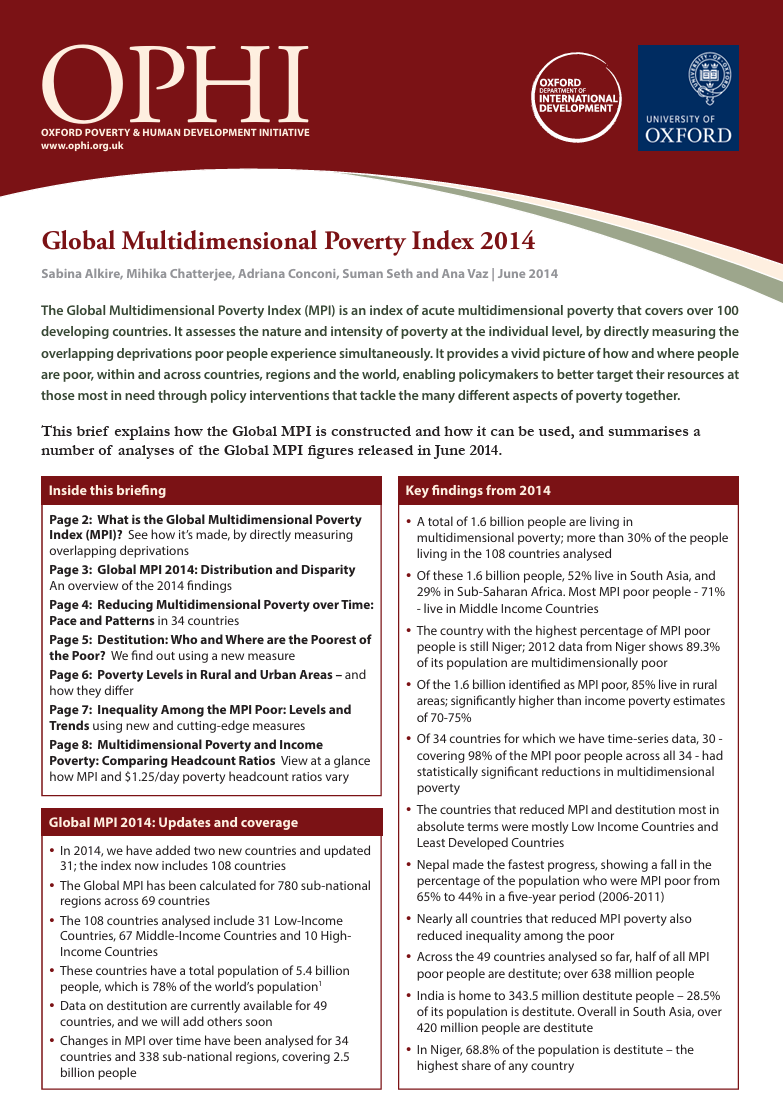Global MPI 2014
The Global MPI 2014 covers 108 countries, which are home to 5.4 billion people using 2010 population data (UNDESA 2013). In 2014, a total of are living in multidimensional poverty; more than 30% of all people living in these countries. In 2014, we analysed how multidimensional poverty changed in 34 countries and 338 sub-national regions covering 2.5 billion people - just over one-third of the world’s population. These nations are in every geographic region in the developing world, and include Low, Lower Middle, and Upper Middle Income Countries, with a Gross National Income per capita in 2012 ranging from $320 in Malawi to $10,040 in Gabon.
Our briefings
The following briefings were published in June:
- Alkire, S., Conconi, A., Seth, S. and Vaz, A., (2014). 'Global Multidimensional Poverty Index 2014: In brief'. OPHI Briefing 20, Oxford Poverty and Human Development Initiative (OPHI), University of Oxford. (2 pages)
- Alkire, S., Chatterjee, M., Conconi, A., Seth, S. and Vaz, A., (2014). 'Global Multidimensional Poverty Index 2014: An overview', OPHI Briefing 21, Oxford Poverty and Human Development Initiative (OPHI), University of Oxford. (8 pages).
- Alkire, S., Chatterjee, M., Conconi, A., Seth, S. and Vaz, A., (2014). 'Destitution: Who and where are the poorest of the poor?', OPHI Briefing 22, Oxford Poverty and Human Development Initiative (OPHI), University of Oxford.
- Alkire, S., Seth, S., (2014). 'Inequality among the MPI poor, and regional disparity in multidimensional poverty: Levels and trends', OPHI Briefing 25, Oxford Poverty and Human Development Initiative (OPHI), University of Oxford.
- Alkire, S., Chatterjee, M., Conconi, A., Seth, S. and Vaz, A., (2014). 'Poverty in rural and urban areas: Direct comparisons using the Global MPI 2014', OPHI Briefing 24, Oxford Poverty and Human Development Initiative (OPHI), University of Oxford.
- Alkire, S., Vaz, A., (2014). 'Reducing multidimensional poverty and destitution: Pace and patterns', OPHI Briefing 23, Oxford Poverty and Human Development Initiative (OPHI), University of Oxford.
- Vaz, A., (2014). 'Are children among the poorest?', OPHI Briefing 26, 2014.
- Alkire, S., Conconi, A., Housseini, B., Seth, S., Vaz, A., (2014). 'Africa's New Stories On Multidimensional Poverty', Oxford Poverty and Human Development Initiative (OPHI), University of Oxford.
Our data
The global MPI results are presented in the following Data Tables.
Summer Data Tables
Winter Data Tables
Detailed MPI data is available to download from the tables below. Data Tables 1.1 – 5.3 were updated in Winter 2014/2015 and are appendices to the Methodological Note – Winter 2014/2015. They include:
- Detailed MPI results at the country level (110 countries)
- Breakdown of MPI results by rural and urban areas (108 countries)
- MPI at the sub-national level for 803 regions of 71 countries
Data Table 6.1-6.6 was updated in June 2014 and covers changes to multidimensional poverty over time for 34 countries and their sub-national regions where possible. It is an appendix to the Methodological Note – Winter 2014/2015 and Multidimensional Poverty Dynamics: Methodology and Results for 34 countries.
The tables are divided into sheets to help in navigating through the data. The chart below provides detailed information on what is included in each data table and sheet. You can download the tables by clicking on the icons in the right-hand column.
Citations: Please cite MPI data from Data Tables 1.1 – 5.3 as: Alkire, S., Conconi, A., Robles, G. and Seth, S. (2015). “Multidimensional Poverty Index, Winter 2014/2015: Brief Methodological Note and Results.” OPHI Briefing 27, University of Oxford, January.
Please cite data from Data Tables 6.1-6.6 as: Alkire, S., J. M. Roche and A. Vaz (2014): “Multidimensional Poverty Dynamics: Methodology and Results for 34 countries”, Oxford Poverty and Human Development Initiative, Oxford University. ophi.qeh.ox.ac.uk



